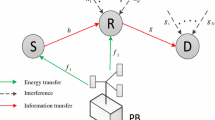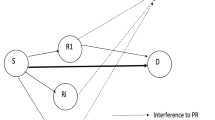Abstract
In this paper we investigate the combination of rate and power allocation techniques in an orthogonal cooperative scheme using infra-structured (fixed) relays, under the incremental decode-and-forward protocol. We consider realistic large scale and small scale path loss models, taking into account the antennas heights and the presence or not of line-of-sight. Results demonstrate that the throughput performance can be significantly increased in the low signal-to-noise ratio (SNR) region due to rate allocation (RA), and in the high SNR region due to power allocation (PA). In addition, we present an energy efficiency analysis which shows that RA is much more efficient than PA over the whole SNR range.









Similar content being viewed by others
Notes
Throughout this paper, we interchangeably refer to the source as S or MS. We also refer to the destination as D or BS.
Note that since the previous direct packet was in outage, only the retransmitted packet is considered.
Recall that the power allocated to the relay is given by P *R = P T − P *S , since the system is subjected to a total power constraint.
References
Ahmed, N., & Aazhang, B. (2007). Throughput gains using rate and power control in cooperative relay networks. IEEE Transactions on Communications, 55(4), 656–660. doi:10.1109/TCOMM.2007.894121.
Alamouti, S. (1998). A simple transmit diversity technique for wireless communications. IEEE Journal on Selected Areas in Communications, 16(8), 1451–1458. doi:10.1109/49.730453.
Alves, H., Souza R. D., Brante G. G. O., & Pellenz, M. E. (2011). Performance of type-i and type-ii hybrid arq in decode and forward relaying. In: Proceedings of the IEEE vehicular technology conference (VTC’11 Spring).
Biggs, M. C. (1975). Constrained minimization using recursive quadratic programming. In L. C. W. Dixon & G. P. Szergo (Eds.), Toward global optimization (pp. 341–349). North-Holland.
Biglieri, E., Caire, G., & Taricco, G. (2001). Limiting performance of block-fading channels with multiple antennas. IEEE Transactions on Information Theory, 47(4), 1273–1289. doi:10.1109/18.923715.
Boyd, S., & Vandenberghe, L. (2004). Convex optimization (1st ed.). Cambridge: Cambridge University Press.
Chen, G., Hanson, S., Blaauw, D., & Sylvester, D. (2010). Circuit design advances for wireless sensing applications. Proceedings of the IEEE, 98(11), 1808–1827. doi:10.1109/JPROC.2010.2053333.
Cui, S., Goldsmith, A., & Bahai, A. (2003). Energy-constrained modulation optimization for coded systems. In IEEE global telecommunications conference (vol. 1, pp. 372–376). doi:10.1109/GLOCOM.2003.1258264.
Cui, S., Goldsmith, A., Bahai, A. (2005). Energy-constrained modulation optimization. IEEE Transactions on Wireless Communications, 4(5), 2349–2360. doi:10.1109/TWC.2005.853882.
de Oliveira Brante, G. G., Pellenz, M. E., & Souza, R. D. (2011). Spectrally efficient incremental relaying for coverage expansion in cellular networks with heterogeneous path loss conditions. Wireless Personal Communications. doi:10.1007/s11277-011-0221-y.
Foschini, G. J. (1996). Layered space-time architecture for wireless communication in a fading environment when using multi-element antennas. Bell Labs Technical Journal, 1(2), 41–59. doi:10.1002/bltj.2015.
Freitas, W. D. C., Cavalcanti, F. R. P., & Lopes, R. R. (2005). Hybrid transceiver schemes for spatial multiplexing and diversity in mimo systems. Journal of Communication and Information Systems, 20(3), 141–154.
Goldsmith, A. (2005). Wireless communications. Cambridge: Cambridge University Press.
Han, S. P. (1977). A globally convergent method for nonlinear programming. Journal of Optimization Theory and Applications, 22, 297–309.
Hong, Y. W., Huang, W. J., Chiu, F. H., & Kuo, C. C. J. (2007). Cooperative communications resoure-constrained wireless networks: Exploiting spatial diversity gains in multiuser wireless networks. IEEE Signal Process Mag (pp. 47–57).
IEEE (2007). Multi-hop relay system evaluation methodology (Channel model and performance metric). In IEEE 802.16’s relay task group. URL http://www.ieee802.org/16/relay/docs/80216j-06_013r3.pdf.
IEEE (2009). IEEE standard for local and metropolitan area networks–Part 16: Air interface for broadband wireless access systems–amendment 1: Multihop relay specification. In IEEE Std 802.16jTM-2009.
Kadloor, S., & Adve, R. (2010). Relay selection and power allocation in cooperative cellular networks. IEEE Transactions on Wireless Communications, 9(5), 1676–1685. doi:10.1109/TWC.2010.05.090307.
Knopp, R., & Humblet, P. (2000). On coding for block fading channels. IEEE Transactions on Information Theory, 46(1), 189–205. doi:10.1109/18.817517.
Kramer, G., Gastpar, M., & Gupta, P. (2005). Cooperative strategies and capacity theorems for relay networks. IEEE Transactions on Information Theory, 51(9), 3037–3063. doi:10.1109/TIT.2005.853304.
Laneman, J., Tse, D., & Wornell, G. (2004). Cooperative diversity in wireless networks: Efficient protocols and outage behavior. IEEE Transactions on Information Theory, 50(12), 3062–3080. doi:10.1109/TIT.2004.838089.
Luo, J., Blum, R., Cimini, L., Greenstein, L., & Haimovich, A. (2007). Decode-and-forward cooperative diversity with power allocation in wireless networks. IEEE Transactions on Wireless Communications, 6(3), 793–799. doi:10.1109/TWC.2007.05272.
Luo, Z. Q., & Yu, W. (2006). An introduction to convex optimization for communications and signal processing. IEEE Journal on Selected Areas in Communications, 24(8), 1426–1438. doi:10.1109/JSAC.2006.879347.
Ma, K., Liu, Z., & Guan, X. (2010). Joint relay selection and power allocation for cooperative cellular networks. Wireless Personal Communications. doi:10.1007/s11277-010-0200-8.
Malkamaki, E., & Leib, H. (1999). Coded diversity on block-fading channels. IEEE Transactions on Information Theory, 45(2), 771–781. doi:10.1109/18.749028.
Nosratinia, A., Hunter, T., & Hedayat, A. (2004). Cooperative communication in wireless networks. IEEE Communications Magazine, 42(10), 74–80. doi:10.1109/MCOM.2004.1341264.
Peters, S., & Heath, R. (2009). The future of WiMAX: Multihop relaying with IEEE 802.16j. IEEE Communications Magazine, 47(1), 104–111. doi:10.1109/MCOM.2009.4752686.
Powell, M. J. D. (1978). A fast algorithm for nonlinearly constrained optimization calculations (Lecture Notes in Mathematics, Vol. 630). Berlin: Springer.
Sadek, A. K., Han, Z., & Liu, K. J. R. (2010). Distributed relay-assignment protocols for coverage expansion in cooperative wireless networks. IEEE Transactions on Mobile Computing, 9(4), 505–515. doi:10.1109/TMC.2009.132.
Savazzi, S., & Spagnolini, U. (2007). Cooperative space-time coded transmissions in nakagami-m fading channels. In IEEE global telecommunications conference (GLOBECOM), (pp. 4334–4338). doi:10.1109/GLOCOM.2007.824.
Sendonaris, A., Erkip, E., & Aazhang, B. (2003). User cooperation diversity-part I: System description. IEEE Transactions on Communications, 51(11), 1927–1938. doi:10.1109/TCOMM.2003.818096.
Shi, Y., Mallik, R. K., & Letaief, K. B. (2010). Power control for relay-assisted wireless systems with general relaying. In IEEE international conference on communications (ICC), (pp. 1–5). doi:10.1109/ICC.2010.5502410.
Vardhe, K., Reynolds, D., & Woerner, B. (2010). Joint power allocation and relay selection for multiuser cooperative communication. IEEE Transactions on Wireless Communications, 9(4), 1255–1260. doi:10.1109/TWC.2010.04.080175.
Wang, H., Xiong, C., & Iversen, V. B. (2009). Uplink capacity of multi-class IEEE 802.16j relay networks with adaptive modulation and coding. In: IEEE International conference on communications (ICC), (pp. 1–6). doi:10.1109/ICC.2009.5199552.
Wolniansky, P., Foschini, G., Golden, G., Valenzuela, R. V-BLAST: an architecture for realizing very high data rates over the rich-scattering wireless channel. In 1998 URSI international symposium on signals, systems, and electronics. Conference proceedings (Cat. No.98EX167), (pp. 295–300). doi:10.1109/ISSSE.1998.738086.
Xu, H., Huang, L., Wang, G., Xu, T., & Liu, G. (2010). Joint relay assignment and power allocation for cooperative communications. Wireless Networks, 16(8), 2209–2219. doi:10.1007/s11276-010-0254-2.
Yanikomeroglu, H., Falconer, D., & Periyalwar, S. (2004). Range extension without capacity penalty in cellular networks with digital fixed relays. In IEEE global telecommunications conference (GLOBECOM), (pp. 3053–3057). doi:10.1109/GLOCOM.2004.1378913.
Yilmaz, E., Knopp, R., Gesbert, D. (2009). On the gains of fixed relays in cellular networks with intercell interference. In IEEE 10th workshop on signal processing advances in wireless communications, (pp. 603–607). doi:10.1109/SPAWC.2009.5161856.
Acknowledgments
This work was partially supported by CNPq and CAPES (Brazil).
Author information
Authors and Affiliations
Corresponding author
Rights and permissions
About this article
Cite this article
Alves, H., Brante, G., Souza, R.D. et al. Energy efficiency and throughput performance of power and rate allocation on incremental decode-and-forward relaying. Wireless Netw 18, 495–505 (2012). https://doi.org/10.1007/s11276-012-0414-7
Published:
Issue Date:
DOI: https://doi.org/10.1007/s11276-012-0414-7




